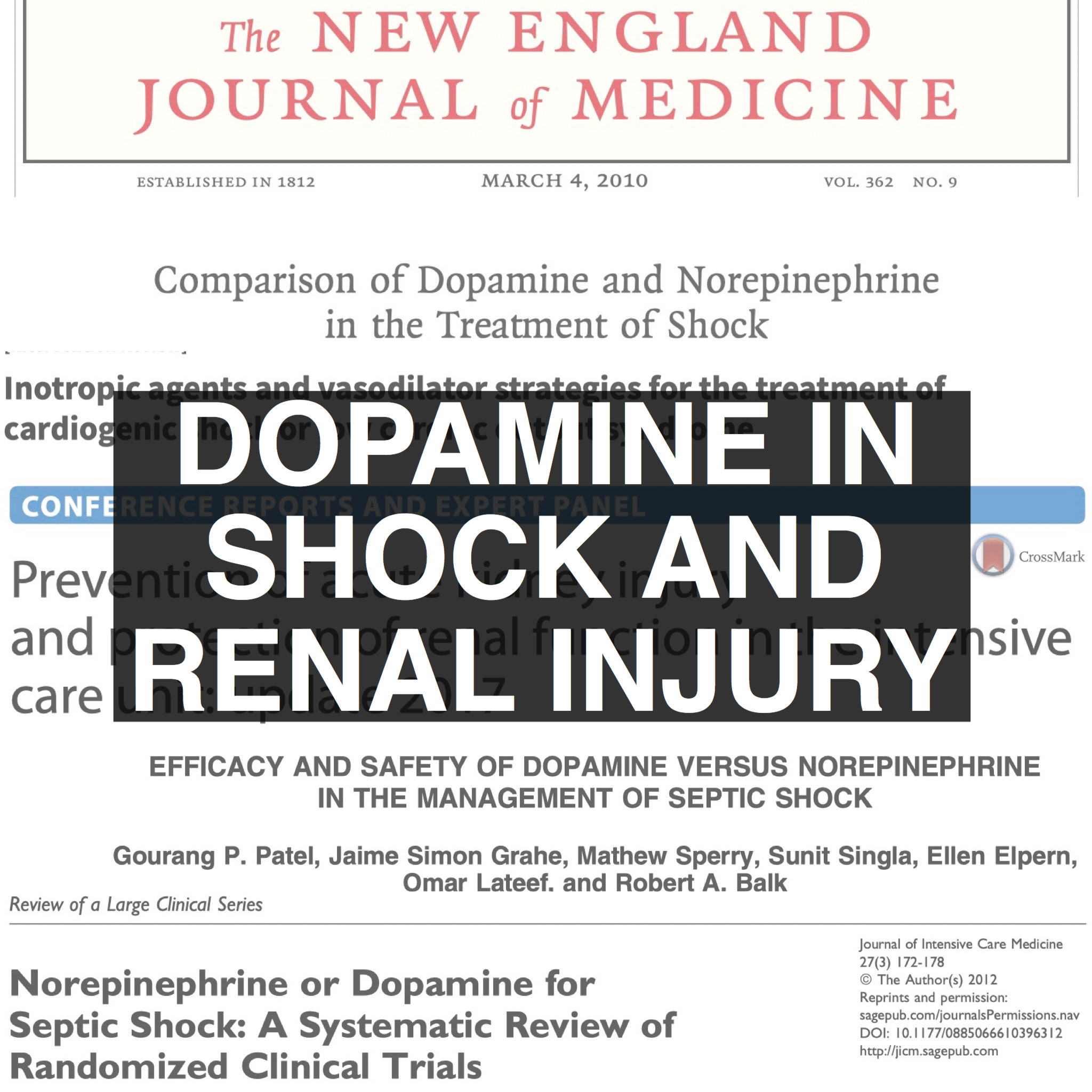In pursuit of evidence-based rationales for my hatred of dopamine, I turned to PubMed and queried the database for “dopamine shock” filtered for meta-analyses, randomized controlled trials, and systematic reviews in adult patients since 2009. I then ventured into the PubMed black hole. 😛
The SOAP-II multicenter randomized controlled trial (RCT) studied ~1,700 patients in shock (primarily septic, but also cardiogenic and hypovolemic) randomized to receive either norepinephrine (NE) or dopamine (DA) with an intention-to-treat analysis looking at all-cause mortality at 28 days. Although there was no significant difference in mortality rate between the two cohorts, DA was associated with more arrhythmias and increased 28-day mortality in the subgroup with cardiogenic shock. Patel et. al. also performed a smaller RCT (published in Shock) of 252 patients showing similar results regarding no difference in mortality between NE and DA in septic shock but increased arrhythmias in the latter cohort. Vasu et. al. performed a systematic review (however, only consisting of six articles) of NE versus DA cohorts in shock (primarily septic). The meta-analysis showed statistically significant superiority of NE over DA for 28-day all cause mortality and less arrhythmias.
Roughly 50% of ICU patients incur acute kidney injury (AKI) which is, in turn, independently associated with acute and chronic morbidity/mortality. The concept of “renal dose” DA aims to promote renal vasodilation and blood flow in the background of vasoconstrictors. The AKI section of the European Society of Intensive Care Medicine (ESICM) performed a systematic review of the literature and arrived at comprehensive, expert recommendations. Among these is a statement “against low-dose dopamine for protection against AKI (Grade 1A)” citing several meta-analyses which showed that “renal dose dopamine” provides no benefit in prevention or correction of AKI in the critically ill population.
Yes, a study’s conclusion(s) are only as good as its design and limitations. Yes, there are many factors to consider (ie, subtypes of shock, provisions for additional therapies, fluid management, etc.) Nevertheless, it’s interesting to see how dopamine doesn’t seem to be first line for anything. In my own practice, I never use it because I think (anecdotally and based on the literature), there are just better options.
Does your facility use dopamine? Drop me a comment with your thoughts!
- De Backer D, Biston P, Devriendt J, et al. Comparison of dopamine and norepinephrine in the treatment of shock. N Engl J Med. 2010;362(9):779–789. doi:10.1056/NEJMoa0907118
- Patel GP, Grahe JS, Sperry M, et al. Efficacy and safety of dopamine versus norepinephrine in the management of septic shock. Shock. 2010;33(4):375–380. doi:10.1097/SHK.0b013e3181c6ba6f
- Vasu TS, Cavallazzi R, Hirani A, Kaplan G, Leiby B, Marik PE. Norepinephrine or dopamine for septic shock: systematic review of randomized clinical trials. J Intensive Care Med. 2012;27(3):172–178. doi:10.1177/0885066610396312
- Joannidis M, Druml W, Forni LG, et al. Prevention of acute kidney injury and protection of renal function in the intensive care unit: update 2017 : Expert opinion of the Working Group on Prevention, AKI section, European Society of Intensive Care Medicine. Intensive Care Med. 2017;43(6):730–749. doi:10.1007/s00134-017-4832-y
- Friedrich JO, Adhikari N, Herridge MS, Beyene J. Meta-analysis: low-dose dopamine increases urine output but does not prevent renal dysfunction or death. Ann Intern Med. 2005;142(7):510–524. doi:10.7326/0003-4819-142-7-200504050-00010
- Karthik S, Lisbon A. Low-dose dopamine in the intensive care unit. Semin Dial. 2006;19(6):465–471. doi:10.1111/j.1525-139X.2006.00208.x
- Holmes CL, Walley KR. Bad medicine: low-dose dopamine in the ICU. Chest. 2003;123(4):1266–1275. doi:10.1378/chest.123.4.1266







I love the way you redesigned your website. Not a physician, but a nurse. At our facility, dopamine is not used often. Most of the time we utilize norepinephrine first line for shock.
Thanks so much, Alton! I appreciate any feedback regarding the website’s design, so let me know what you like and what else you’d like to see!